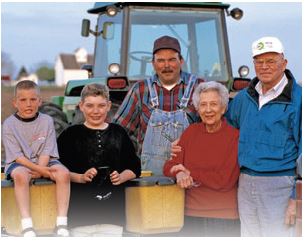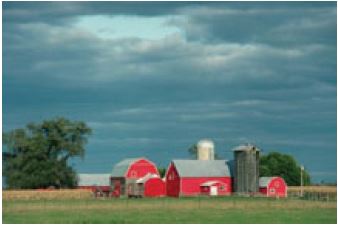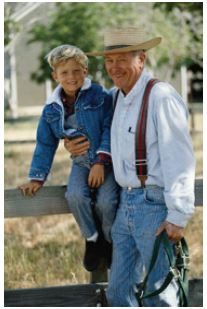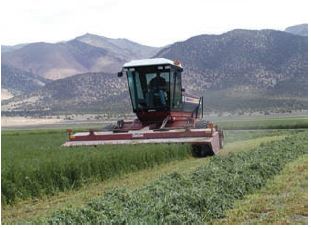A common misconception among farmers and ranchers is that “the best way to protect farmland is to farm it”.1 While maintaining a working operation may be important as a personal or family goal, one of the best ways to protect farmland is proper estate planning.
Farming and ranching, like any business, can be a risky venture. Additionally, farmland preservation has become increasingly endangered, as the market value of farmland is often higher for non-farm uses. Farmland is especially vulnerable to conversion pressures when passing from one owner to the next. For these reasons even families that plan to pass on the farm/ranch to the next generation can lose their land without sound estate planning. Good estate planning can help transfer both the land and the business from generation to generation.
Reasons People Avoid Estate Planning
There are three common reasons that people avoid estate planning.
“Our family knows how we want to divide our assets-we don't need a will.”
Some families believe that they don't need a will because they have made their intentions known to the next generation, or because they only have a limited number of heirs or a small amount of assets. However, if a decedent doesn't have a will in place at the time of death, the state has the authority to allocate the assets per state law, regardless of the decedent's wishes or the wishes of the decedent's heirs.
“We’ve had a will for years-our estate is planned.”
Although drafting a will is a very important part of estate planning, it is not enough. Estate planning outlines the distribution of assets like a will, but it can also create financial security for heirs, address business organization issues, and grant peace of mind to heirs and the grantor. As tax laws constantly change and families grow, it is important to revisit and update your will at least every few years.

“We don't need an estate plan-we'll divide everything equally among our children.”
A major estate planning issue with farm and ranch families is the allocation of assets among farm and non-farm children. While giving each child an equal share of the assets may seem like the most equitable solution, such a plan could result in the future loss of the farm or ranch.
For example, consider a family with four children, three off-farm, one on-farm. If the parents leave equal shares of the family assets to each child, the on-farm child may not be able to afford to buy the farm shares from his/her siblings who want a cash settlement, resulting in a farm sale in the end.
Estate planning can help families find the most equitable distribution of assets, which may not be a completely equal distribution.
Five Goals of Estate Planning
The five basic goals behind estate planning are the following:
Transfer Ownership
The primary goal of estate planning is to facilitate the transfer of ownership and management of the farm business, farmland, and other assets. Estate planning ensures that the farm/ranch will be passed along to the intended party with as few complications as possible.
Reduce Estate Taxes
The second goal of estate planning is avoiding unnecessary transfer taxes. Transferring ownership of assets can be very complicated for the layman, and amid the complex laws and confusing language is the potential for extreme transfer taxes. Planning the estate with the assistance of a knowledgeable professional (a lawyer well-versed in tax law would be best) will help limit the taxes the estate has to pay.
Secure Financial Future
The third goal of estate planning is to ensure financial security for all generations. As mentioned before, without proper documentation showing how assets should be allocated, the state has the ability to distribute the estate as it sees fit. Just as important, the estate can be set up so that the costs of medical care, funeral costs, and the costs of settling the estate are covered by the estate, rather than on the shoulders of the estate's beneficiaries. The estate can also be set up to provide living costs, educational costs and more for the surviving heirs.
Develop Management Skills
The fourth goal of estate planning in the farm/ranch context is to develop the next generation's management skills. With a properly planned estate, you and your family can choose the business ownership structure and asset transfer methods that allow the younger generation to participate in the management and ownership of your farm/ranch as soon as both generations are ready.
Keep Land in Agriculture
The fifth goal of estate planning may be to keep productive land in agriculture. There are different mechanisms that can be used to ensure that the farm/ranch will continue to be actively used in agriculture in the future, such as conservation easements.

Starting an Estate Plan
The following tips can help give farmers and ranchers an idea of how to start their estate plan.
Set Goals
As you begin to consider the estate planning process, take some time to set basic goals for your estate and keep these goals in mind throughout the entire process. This will help keep you on track.
What kind of goals should be considered? Ask yourself the following questions as a start:
- Do you want to generate income for retirement?
- How will you support yourself or your spouse in the case of a medical emergency or disability?
- Who do you want to make decisions about your property if you are ill or after you die?
- Who do you want to take charge of the farm after you die?
- How will the costs of settling your estate be paid?
- How will you ensure financial security of your surviving family members?
- How will you minimize estate taxes?
Inventory Your Assets & Assemble Your Team
To plan your estate properly, you must know your financial worth, so accurate estimates of your asset values are very important. When it comes time for you to inventory your assets, you should involve your accountant and/or lawyer for guidance. In addition to your personal assets, you should determine the exact value of your business assets as well as any debts you or your business owe.
Determine Ownership & Assets
Make sure you know all of the associated business and legal relationships involved in your estate. For example, many farm/ranch couples have joint ownership of their land and business with rights of survivorship. With this sort of a business ownership, the farm/ranch will be passed on to the surviving spouse regardless of the wishes of the other survivors. It is essential that you know how your business is structured. Below are several common forms of business ownership and their associated implications.
Sole proprietor
the most common form of agricultural business ownership. The business is owned by only one person, who is liable for all debts and obligations of the business.
Partnership
involves two or more parties, who are liable for all debts and obligations of the business. Often used as a way to bring family members into the business by sharing ownership and operating assets while giving the younger party the opportunity to build equity in the business.
Limited partnership
creates two classes of partners: general or managing partners and limited partners. General/managing partners control the partnership and are liable for the debts and obligations of the business. Limited partners are passive investors who do not manage the business and whose liability is limited to their investment. Often, farm/ranch families create a limited partnership to accommodate farm and off-farm children: the farm children become managing partners while the off-farm children are limited partners.
Corporation
established as a legal entity separate from the owner(s) to provide liability protection to shareholders. Aside from liability protection, one benefit of corporations is that they continue to exist even as individual owners change. Due to high income tax rates, corporations are better suited to large-scale farm/ranch operations.
Limited liability corporation (LLC)
combines the limited liability of a corporation with the flexibility and tax schedule of a partnership. An LLC can also be used as the general partner in a limited partnership, giving the individual owner(s) protection from liability.

Estate Planning Examples1
Joint Ownership With Rights of Survivorship
Jim and Frances Smith own and operate a 500-acre dairy farm with 300 cows. They have four grown children, two who live on-farm, and two who are off-farm. Jim and Frances share ownership of the farm through joint tenancy with rights of survivorship. Although they do have a will, it was drafted when the children were young and does not reflect their current $1.3 million net worth. Jim and Frances would like to pass ownership of the farm along to their on-farm children, and would like to bequest an equitable monetary amount to their off-farm children.
With no additional estate planning, if Jim and Frances were involved in an accident and passed on at the same time, or within several weeks of one another, it is likely that their assets would be divided equally among their four children. If this was the case, how would the on-farm children come up with the money to buy the farm shares from the off-farm children? If the on-farm children were unable to come up with the money necessary to buy out their siblings, the farm may end up being sold off, opening up the possibility that the land would not stay in agriculture, nor would it stay in the family.
One solution would be to draft a buy/sell agreement. A buy/sell agreement could set the price and terms of the siblings' buyout and could address potential financing options as well. A well-structured buy/sell agreement would ensure that Jim and Frances' children could retain ownership of the farm after they pass on.

A second solution would be to split the estate. As the estate is set up now, if Jim passes on before Frances, with rights of survivorship Frances would receive Jim's half-interest in the farm. By changing the ownership of the farm from joint tenancy to tenancy in common, Jim and Frances could each leave their half-interest in the farm to the on-farm children in their will. Another option would be to leave each half-interest to a trust, with instructions to the trustee that keeping the land in agriculture is a priority and that the land must be sold to the on-farm children according to pre-arranged terms. In addition to creating more assurance that the farm stay in the family and in agriculture, such an estate split would allow Jim and Frances to maximize the use of their applied tax credits, doubling the amount of assets they can pass on to their children free from federal estate taxes.
Waiting Until the Last Minute
When Bill and Roberta purchased their farmland in the early 1960s, they paid $250/acre. The current value of the land is $1500/acre. Bill and Roberta would like to retire to Arizona, leaving the management and ownership of the farm to their son, Roy, the only of their four children who lives on-farm. Bill and Roberta have reached their mid-60s and would like to retire in the next two years, but have no estate planning in place.
As the majority of Bill and Roberta's net worth is tied up in their land, an immediate sale of the land would mean huge capital gains tax for Roy.
If Bill and Roberta were to pass on before resolving their estate issues, it would be virtually impossible for Roy to come up with the money necessary to buy out his siblings. No matter what estate plan Bill and Roberta end up choosing, the first step for them is to start the immediate transfer of assets to Roy by sale and by gift. This will reduce the amount of land retained by Bill and Roberta and will also provide Roy with additional liquidity to buy out his siblings if need be. The next move may be for Bill and Roberta to create a family limited partnership. The limited partnership would retain ownership of the land, while managing interest would be given to Roy and the other children would hold limited partnership investment interests.
Regardless of what Bill and Roberta decide to do, it is essential that they move quickly. Waiting until retirement age to begin estate planning limits the amount of assets that can be passed along as tax-free gifts and may limit estate planning options.
Summary
Regardless of the techniques you use to plan your estate, keep in mind that estate planning involves some of the most important family, business, financial, legal, and tax decisions you will ever make. You must have confidence in your advisors and be able to work with them on an ongoing basis. Estate planning can be time consuming and costly, but neglecting to plan can cost your family a lot more than creating a plan.
References
American Farmland Trust, “Farm Transfer and Estate Planning.” Farmland Information Center Fact Sheet and Technical Memo, 2004.
Cosgrove, Jeremiah P. and Julia Freedgood: “Your Land is Your Legacy: A Guide to Planning for the Future of Your Farm.” American Farmland Trust, 2002.
Iowa State University Extension, “Two-Generation Farming.” Iowa State University Extension Publication Pm-1474a, 1998.
1 Crosgrove and Freedgood, 2002.


